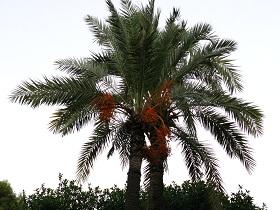From Architecture to AI-Powered Building Diagnostics: Tarek Rakha’s start-up story
10 June 2025
Published online 29 May 2011

Date palm farmers might soon be able to increase their crop yield by up to 100%, thanks to new research from Weill Cornell Medical College in Qatar (WCMC-Q)1.
Unlike many flowering plants, date palms are dioecious in that they have separate male and female plants. Only the female date palm bears fruit, which is a staple food across the Middle East and North Africa. Yet there is no way for a farmer to tell the gender of a plant before it matures, which takes around five years.
The researchers at WCMC-Q managed to assemble a draft of the date palm genome and then identified gene sequences linked to gender inheritance, and publish their results in Nature Biotechnology today.
"There are many sex-determination systems in nature. Plants are among the most diverse in the different ways gender is determined, including through temperature and nutrients among others," said Joel Malek, a geneticist at WCMC-Q who led the research. "Even up until this year many people believed the date palm would employ one of these 'non-traditional' methods of gender determination."
Similar to the XY-system of chromosomes in humans, the male date palm determines the gender of the offspring. Unlike humans, however, the sex chromosomes in the date palm are homomorphic. "They are very similar in size and appearance under a microscope, resulting in us requiring comparative sequencing to identify the region. That differs from humans where the X and Y chromosomes are so different in size you can readily differentiate them using microscopy."
Breeders should now be able to determine the gender of the date palm as a seedling as DNA can be extracted from the leaves. "As soon as a method is developed to extract DNA from the embryo, while not affecting the viability of the seed, we will be able to do it from the seed stage," says Malek. "I do not imagine this is far off as it has been done in many other plants."
A draft copy of the date palm genome will immensely help our comprehension of the date palm...Really, the uses are almost endless.
"Being able to determine the gender of seedlings early on in its development would indeed be useful. It would allow a plant breeder to select only male or female plants without having to wait several years for maturity," said Abdelouahhab Zaid, director of the Date Palm Research & Development Programme in the United Arab Emirates.
This would be useful when breeding date palms for a certain trait, such as disease resistance, says Zaid, "without wasting any resources on bringing up trees which will not be used downstream in the breeding programme."
"Most breeders are interested in the date producing females so 'wasting' space, water, fertilizer and time on the males will hopefully no longer be a problem," adds Malek.
The date palm is one of the three most economically important woody palms, along with coconut and oil palms. It is historically one of the most important sources of dietary carbohydrates in the Middle East and North Africa, where millions of trees are cultivated. The researchers sequenced the genome of three of the most popular varieties of date palm: Khalas, Deglet Noor and Medjool.
The researchers might have also pinpointed genes responsible for important traits such as fruit colour, smell and ripening time. "An additional gene family with significant differences was the lignin family involved in water transport within the plant and may be important in things such as drought resistance," says Malek.
The gene families responsible for fruit quality are next on Malek's agenda and are important targets for breeders to improve the varieties of date palms.
"A draft copy of the date palm genome will immensely help our comprehension of the date palm. It should provide a rich source of genetic data, from which genes of interest can be identified," says Zaid. "[It] will also allow gene-identification, which in turn could help elucidate metabolic pathways and interactions in date palm. Really, the uses are almost endless."
Date palms are usually cultivated through offshoot propagation, where buds produced in the axils of dead leaves of the palm are cut off and replanted elsewhere. This produces date palms that yield fruit of similar colour and size, which is preferred for packaging.
However, continuous offshoot cultivation has decreased genetic variability among date palms. "This is extremely detrimental when a certain disease plagues a farm — because as all trees are clones — the disease would spread very easily not encountering any genetic varieties that may be resistant," says Malek.
"Using the markers we developed will encourage the planting of females that come from normal crosses, not cloned, which hopefully will allow the return of genetic diversity to the date palm," he adds.
doi:10.1038/nmiddleeast.2011.63
Stay connected: